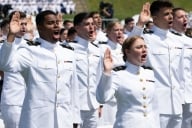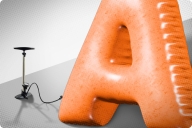You have /5 articles left.
Sign up for a free account or log in.
Showing students how to read critically and formulate research queries is part of the teaching function of college libraries. But how do you teach students to read critically that which has no text?
That is the challenge Frances May, an adjunct librarian at the University of North Texas, took on when she decided to adapt her library’s orientation program to meet what she sees as a growing demand for “visual literacy” among today’s college students.
In today’s information economy, television, film, and increasingly web videos are valuable currencies, May says. And while college students absorb more information from these mediums than ever, many librarians teach their students to devise research questions and keyword searches the same way they themselves learned to do: by working from text-based prompts.
“How many of you have been trained to analyze the things that you see?” May asked a ballroom full of librarians at the annual conference of the Association of College and Research Libraries this month. She counted seven hands. “So what does that tell you?” May continued. “There’s a great big gap between the way that most of us, especially the students, are getting our information, and the way they are trained in critical thinking.”
Visual tricks designed to subtly reinforce rhetoric are nothing new, of course. Art and propaganda have used images, often layered with written or spoken words, for centuries — a technique that tries to evoke a stronger response from the audience than the comparatively bland method of linear, text-based reasoning might have achieved.
But May argues that the noise of the information age has made it more difficult for students today to distinguish the reliable from the apocryphal, and that libraries — which their leaders say are still responsible not only for curating good information but also for teaching students how to use it — are neglecting to train students how to begin parse the multi-front assaults on their brains.
So May decided that instead of simply showing North Texas students how to operate the library search tools, she would try something different. Her program would start by showing the students a short video clip outlining some problem, followed by an exercise designed to encourage students to think critically about the video, develop research questions for further study, and then formulate keyword searches that will retrieve helpful results.
The idea is to help students see dredging up library sources not as some abstract, school-bound set of procedures, but as part of a critical process that applies not just to their assignments, but to their lives. Presented with this perspective, students are less likely to be bored and more likely to remember how to do research after the 50-minute library orientation is over, May says.
She first tested this method in 2008, for a communications class studying poverty. During the library orientation for that class, she showed a three-minute YouTube video about a project aimed at helping fight poverty in Bangladesh. The video shows the beginnings of a talk by the economist Jeffrey Sachs, followed by a montage of an inspired graduate student handing out supplies to grateful villagers. Music swells as the women hang mosquito nets and children leaf raptly through books. Then, in a tender denouement, Sachs reappears, talking about the indomitability of the human spirit. A Bangladeshi boy smiles shyly, looking straight into the camera. “Thank you,” he says.
To the passive observer, it would seem to offer an affirming, unimpeachable narrative. But May wanted students to look beyond the rhetorical onslaught and do some scholarly accounting. She divided the students into groups and instructed them to write “problem statements” relating to important information that was not provided by the video. The students then reconvened to come up with questions to interrogate the issue of poverty in Bangladesh more deeply. Then, with May’s guidance, they translated those questions into keyword searches that might help them locate where in the library they might find answers.
“You could see that they were getting it,” May said at her presentation to fellow librarians at ACRL. “Learn to be critical of the information that’s not given, narrow down the result for research, how to find more and better information. And the legwork and questions you ask beforehand — the preparation is a key to success." (May said that while students did not have time during the library session to critique the video clip in any specific detail, she says she was confident that the method was leading them to sources that would have enabled them to do so, given time.)
Important lessons. But might they be too big to transmit in a one-off, hourlong library orientation? During such sessions, a librarian might barely have enough time to orient the students to the mechanisms to find information, let alone an entirely new way of thinking about information.
Too Big a Bite to Chew?
Julie Tharp, an instructional undergraduate librarian at Arizona State University at Tempe, thinks May is on to something. She thought it would be a good way to introduce the library to students taking a remedial course in critical thinking and reading. She adopted a version of May’s method, using a video clip of a news report about the neurological effects of video game violence on the human brain.
“It seemed pretty obvious that the in-class exercise worked pretty well,” Tharp said at the ACRL event, where she presented alongside May. “Students were very engaged, they learned how to pick keywords.”
But months later, when Tharp and her colleagues analyzed the students’ research papers and bibliographies to assess how well the students had applied those skills over the course of the semester, they were disappointed. “We found that they really didn’t get their sources from [the scholarly database] Academic Search Premier, which is what we really wanted to see,” Tharp said.
Instead, the students “over-relied” on the Opposing Viewpoints Resource Center, a database published by Cengage Learning that provides pre-packaged arguments for different sides of various hot-button issues. This came as a disappointment to both the Tempe librarians and professors, since the students appeared not to have formulated their own threads of critical inquiry, Tharp said.
The orientation method “met our short-term objectives,” she said. “…But when it came time for them to do their own searching on their own topics later, not while they were in the library, they didn’t apply it.”
May says she nonetheless believes her method of orienting students to the library in the context of teaching them to think critically about visual data is better than the alternative.
Certainly, librarians should not expect students to turn overnight into dogged interrogators of apocryphal claims made by talking heads and advertisements because of an hourlong crash course, May says. (Nudging them in that directions must be a coordinated effort by both the instructors who assign the papers and the librarians who help with the research, she adds.) But to the extent that teaching research procedures holistically and with the prevailing media of the day makes students pay attention to what librarians are saying, May thinks her method stands to do more good than harm.
“It used to be that we would bring them in and show them how to find books and articles,” she says. “That sort of comes out of nowhere for them — they have very little context. But when it’s presented in the context of, ‘Oh, here’s this thing I saw on TV, I want to learn more about it, how do I do that?’ Then they’re more likely to retain it and to see the relevance in it.”
For the latest technology news and opinion from Inside Higher Ed, follow @IHEtech on Twitter.








